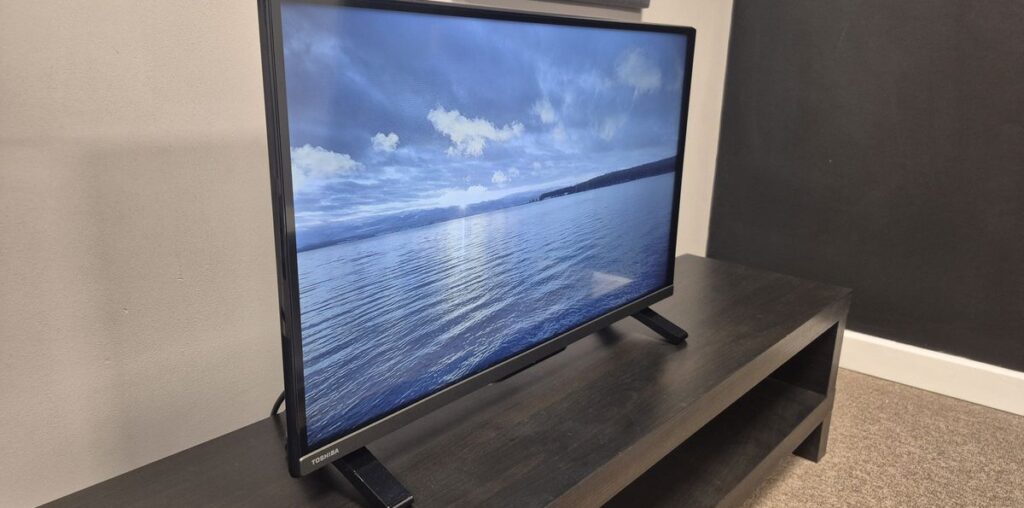The Toshiba 32LF2F53DB is a super-cheap small TV with a flawed, yet competent full HD display. Although the Toshiba 32LF2F53DB has an RRP of £199.99 (not available outside the UK) it’s often available for under £150 – meaning it’s an attractive budget option.
But how good is it really? Well, let’s start where it matters most – picture quality. And I’ll make something clear from the offset – I wasn’t expecting anything incredible from the Toshiba 32LF2F53DB, given it has a 32-inch, LED display. But even still, out of the box, I felt the picture was a touch disappointing, despite HDR support. For example, I tuned into Top Gun Maverick on Netflix and during an outdoor scene set at night, Jennifer Connelly’s hair colour looked slightly inaccurate and features of both her and Tom Cruise – such as lines on their hands and faces – lacked definition and sharpness. Having said that, the general picture quality was still adequate – I wasn’t finding the display to be blurry and even if hair wasn’t replicated impeccably in terms of colour, textures weren’t overly blocky or anything.
Perhaps the most grating part of the viewing experience for me, though, was that the picture could often be pretty dark. For example, I tuned into The Boy and the Heron on Netflix and found that large portions of the movie appeared almost dismal – a shame given it has a lot of bright, colour-popping scenes. Near the beginning of the film, a woman named Natsuko is wearing orange and yellow clothing, which is meant to be vibrant and eye-catching. Instead, though, it had a dullness to it – as did the whole picture. Natsuko’s rich, dark green eyes, Mahito’s clothing and background elements like trees – looked fairly muddied – whether in Movie or Standard picture mode and with dynamic backlight either on or off.
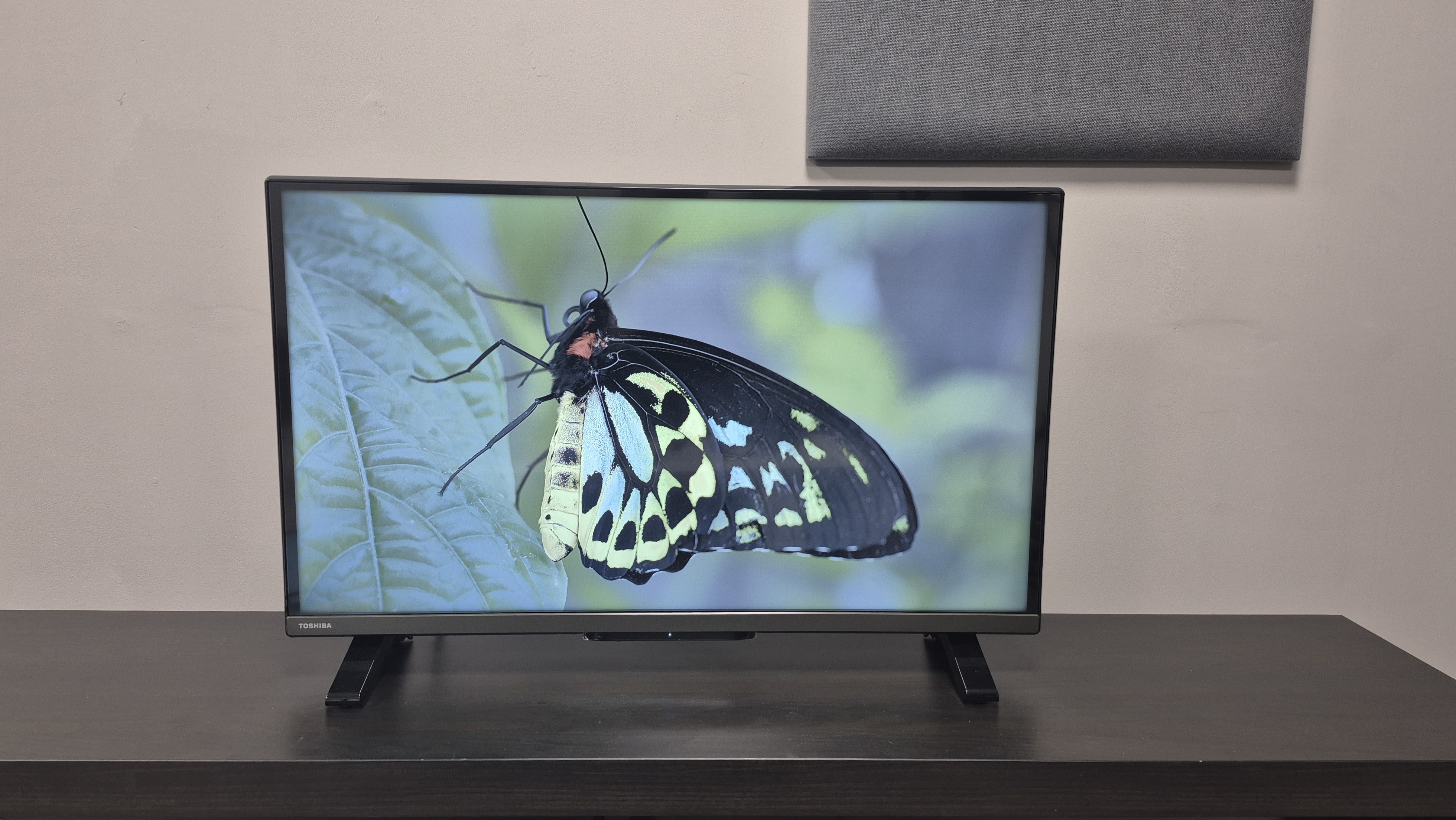
Despite that, when measuring peak brightness on a 10% window test pattern, the result was 228 nits and 207 nits in Standard and Movie mode respectively (in HDR). That’s honestly not awful and pretty similar to other 32-inch TVs we’ve tested, like the TCL 32S5400. While I’m at it, it’s also worth mentioning the results of colour gamut testing. For DCI-P3 (the colour space used to master 4K movies and digital cinema releases), accuracy was 79.9%, whereas BT.2020 was 61.1% – that’s actually a fair step up on the TCL, though these aren’t exactly game-changing results in their own right.
Even still, there were some identifiable issues with colour accuracy from time to time. For instance, when I watched a 4K Blu-ray of Godzilla vs. Kong skin tones – though taking up a relatively natural, true-to-life look in Movie mode – had an almost-artificial, discoloured appearance in Standard. I found that generally using Standard presented a brighter overall display, especially in the opening jungle segment, although again, aspects like long grass could look oversaturated and pretty artificial. Unfortunately for the Toshiba 32LF2F53DB, this is an issue that you won’t have to put up with (at least to the same extent) with some of the best 32-inch TVs. So, even if the picture can appear somewhat underexposed at times, I’d still stick to Movie mode for better accuracy.
One last note on picture – motion isn’t going to blow you away. I noticed a bit of judder when watching the bike chase scene at the start of John Wick 2 (on 4K Blu-ray). This was nothing too offputting in my view and if you want a TV that can replicate high-octane scenes with near-perfect motion, you’ll definitely be better served by an alternative in our guide to the best TVs instead. I will say too, that motion wasn’t all too bad when gaming. After hooking up the XBox Series X and firing up Battlefield V, I found that movement was totally fine. Of course, you don’t get next-gen features like 144Hz refresh rate or 4K graphics, but given the TV’s restrictions, performance was solid.
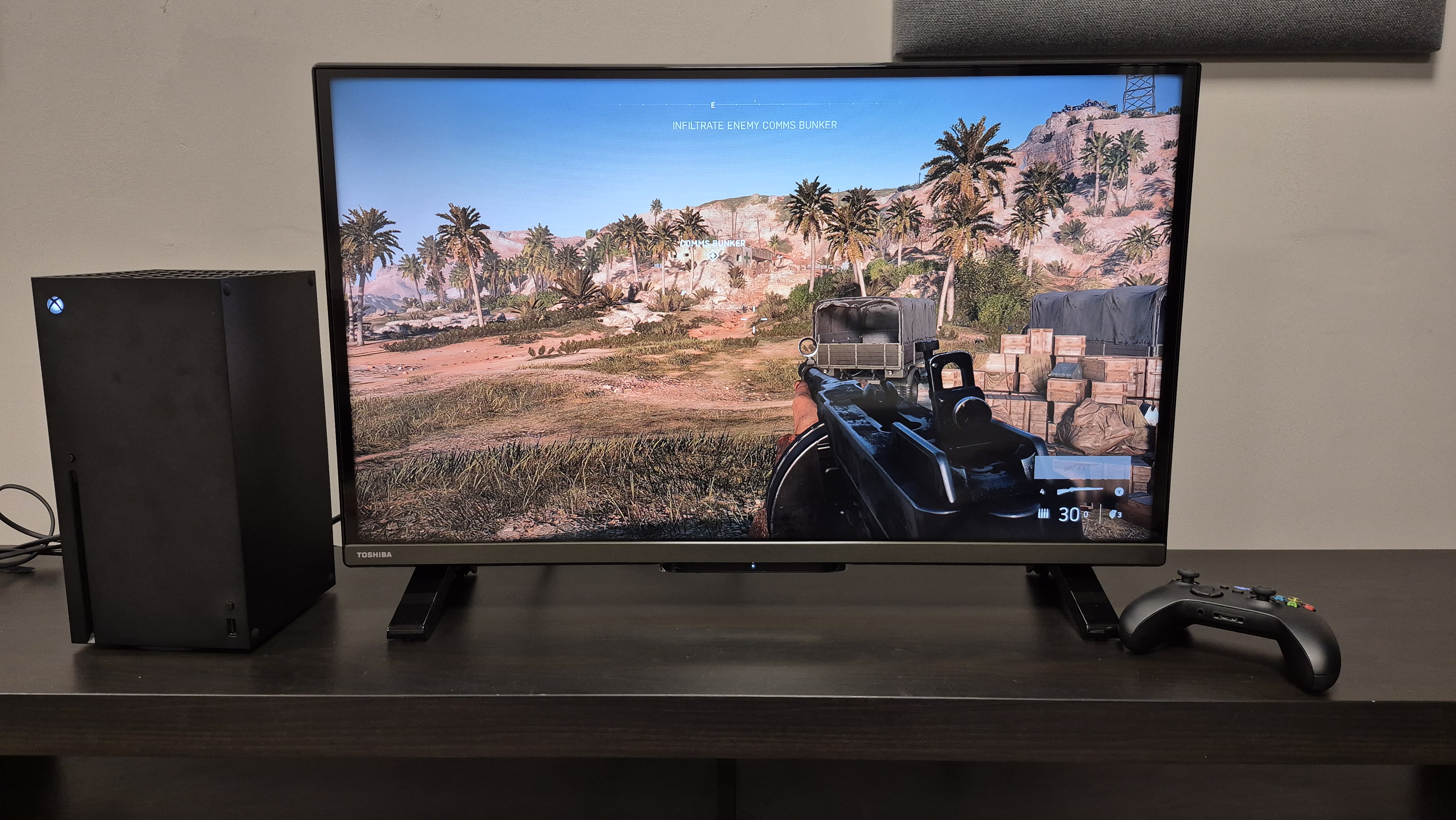
But something different I realised while watching this TV was that audio quality was…well, not very good. Again, you can’t expect wonders from a 32-inch TV, but even still, the Toshiba can struggle, often supplying tinny-sounding audio. Something I noticed instantly when selecting Netflix was that its iconic startup sound was very unnatural. It lacked any of the bassy boom I’ve come to expect and instead took a brash tone, sounding overly-compressed. Even when viewing Godzilla vs. Kong, a narrow soundstage left the movie’s soundtrack sounding restricted and thin, with underwhelming bass and distorted highs. Even when switching between the various Dolby Audio sound modes – or a handful of others – there was no genuine remedy for weak sound performance. If you do opt to grab this Toshiba TV, then, it may well be worth your while to snap up one of the best cheap soundbars.
With that said, there was one side of the Toshiba 32LF2F53DB that impressed me – its smart TV interface. Yes, this TV uses the Fire TV UI – one that many will be well familiar with. And although I may not have got off to the best start with it – given I had to wait more than one minute for the TV to turn on in the first instance – it was very easy to use and navigate. For a cheap TV, I found that sifting through menus was pretty agile, using the digital keyboard was responsive and the Alexa voice assistant was handy too. My only real usability complaint would be that holding the home menu down to change picture and audio settings felt a bit clunky – otherwise the remote is decent quality and complements the Fire TV experience competently.
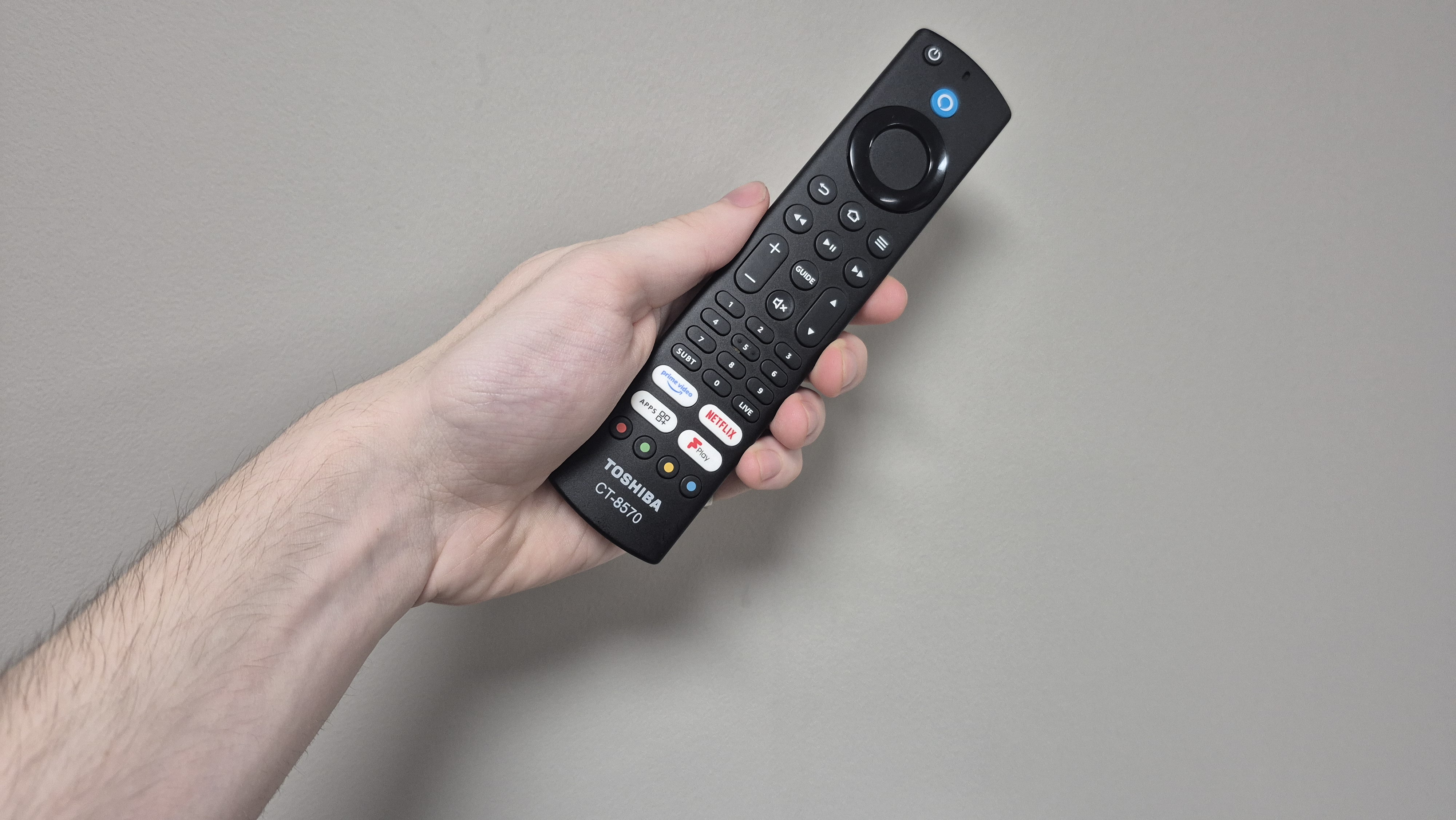
Beyond the remote, the design of this TV is decent. It’s no stunner, but it’s a fairly slim, lightweight TV that will seamlessly slot into a spare room or bedroom. The layout of the ports, though, is admittedly weird. There’s one section on the reverse side of the TV that has a lot of the usual suspects – think headphone, USB-A, digital optical ports, but only room for one HDMI cable. However, I later discovered that there’s another section on the reverse side of the TV with LAN, antenna and thankfully, a second HDMI port, which can be used for ARC (handy for soundbars). This was a little odd, so keep an eye out for this if you’re wondering where that pesky HDMI 2 went.
So, overall, what do I make of the Toshiba 32LF2F53DB? Really, it’s a mixed bag – you get a totally adequate, albeit flawed, display with some colour accuracy issues. Sound quality isn’t very good here unfortunately, despite the inclusion of Dolby Audio and DTS:Virtual X processing, but there are some more redeeming aspects, like a neat smart TV UI. The real draw, though, is an ultra-low price – which overshadows a lot of the issues I have with picture and audio quality. At the end of the day, this is an imperfect, yet capable small TV which is worth considering if you’re on a budget. However, I’d argue there are better budget options out there – namely the LG 32LQ6300 – more on this below.
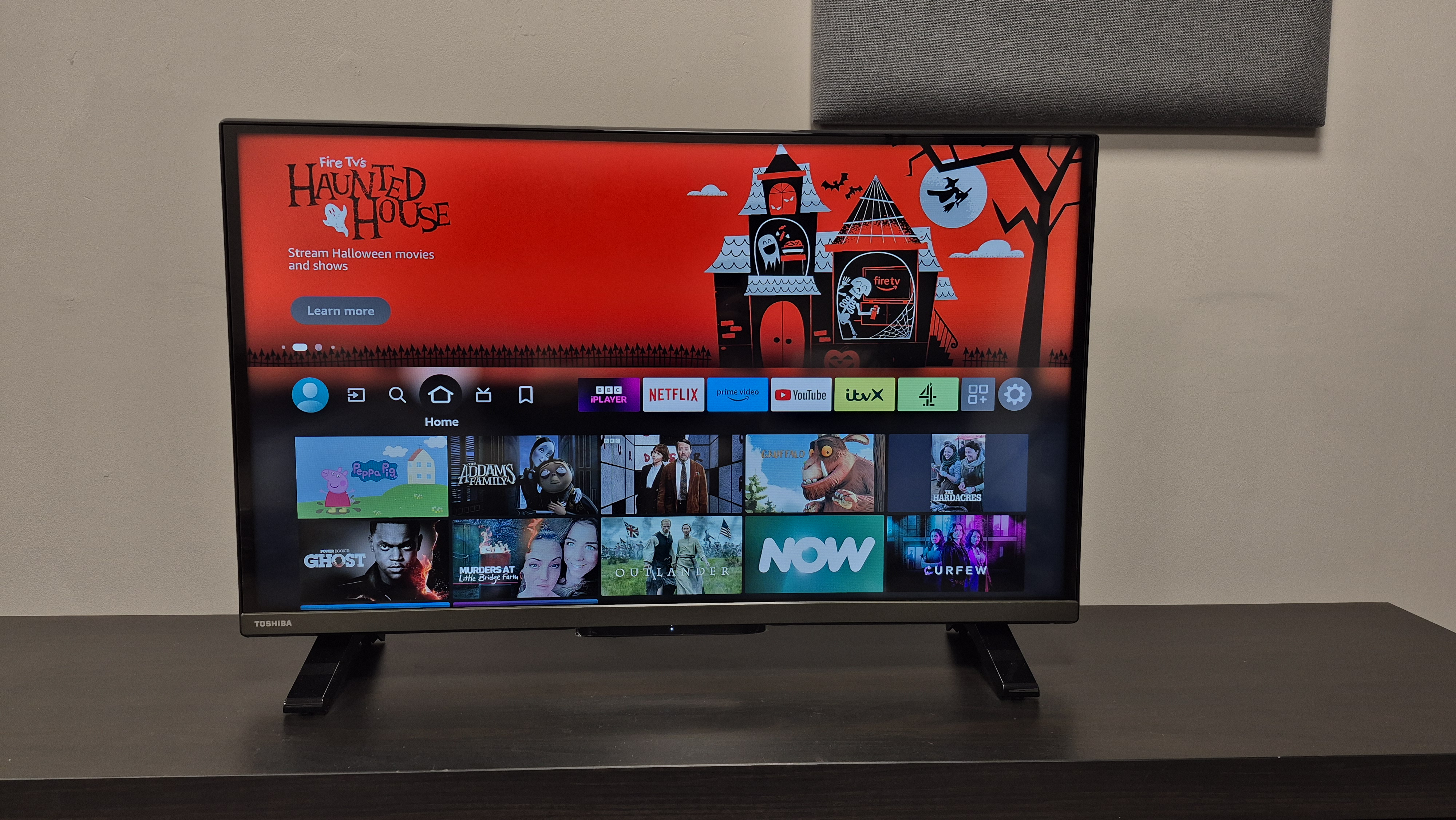
Toshiba 32LF2F53DB review: price & release date
- £199.99 RRP
- Although often available for less than £150
- Launched in 2024
The Toshiba 32LF2F53DB launched in 2024 and has an RRP of £199.99, but I have good news, reader. In most instances, you won’t have to pay anywhere near as much. I’ve already spotted this 32-incher available for as little as £148 – so you’re looking at a very cheap TV here. There are, however, a good selection of small TVs available in this price range, from the Amazon Fire TV 2-Series to the TCL 32S5400 (more on that later). This particular model is only available in the UK, although you can get similar models – like the Toshiba V35 – in the US.
Toshiba 32LF2F53DB review: specs
| Screen type | LED |
| Refresh rate | 60Hz |
| HDR | HDR10, HLG |
| Audio | Dolby Audio, DTS Virtual:X |
| Smart TV | Fire TV |
| HDMI ports | 2x HDMI 2.1 |
Should I buy the Toshiba 32LF2F53DB?
| Attributes | Notes | Rating |
|---|---|---|
| Features | HDR, Alexa voice controls, solid selection of picture modes. | 4/5 |
| Picture quality | Adequate display, though colours can be inaccurate and motion imperfect. | 3/5 |
| Sound quality | Sound is functional but often tinny, especially at high volumes. | 2/5 |
| Design | A basic, inoffensive-looking TV. | 3/5 |
| Smart TV & menus | Relatively smooth menus, easy-to-use UI. | 4/5 |
| Gaming | No shiny next-gen options, but works well for base-level performance. | 3/5 |
| Value | Despite issues, this is still a super-cheap, competent 32-inch TV. | 4/5 |
Buy it if…
Don’t buy it if…
Toshiba 32LF2F53DB review: Also consider
| Row 0 – Cell 0 | Toshiba 32LF2F53DB | LG 32LQ6300 | TCL S5400 |
| Price | £199.99 | $249 / £249 | £179 |
| Screen type | LED | LED | LED |
| Refresh rate | 60Hz | 50/60Hz | 60Hz |
| HDR | HDR10, HLG | HDR10, HLG | HDR10, HLG |
| Smart TV | Fire TV | webOS 22 | Android TV |
| HDMI ports | 2x HDMI 2.1 | 2x HDMI 1.4 | 2x HDMI 1.4 |
Toshiba 32LF2F53DB review: How I tested
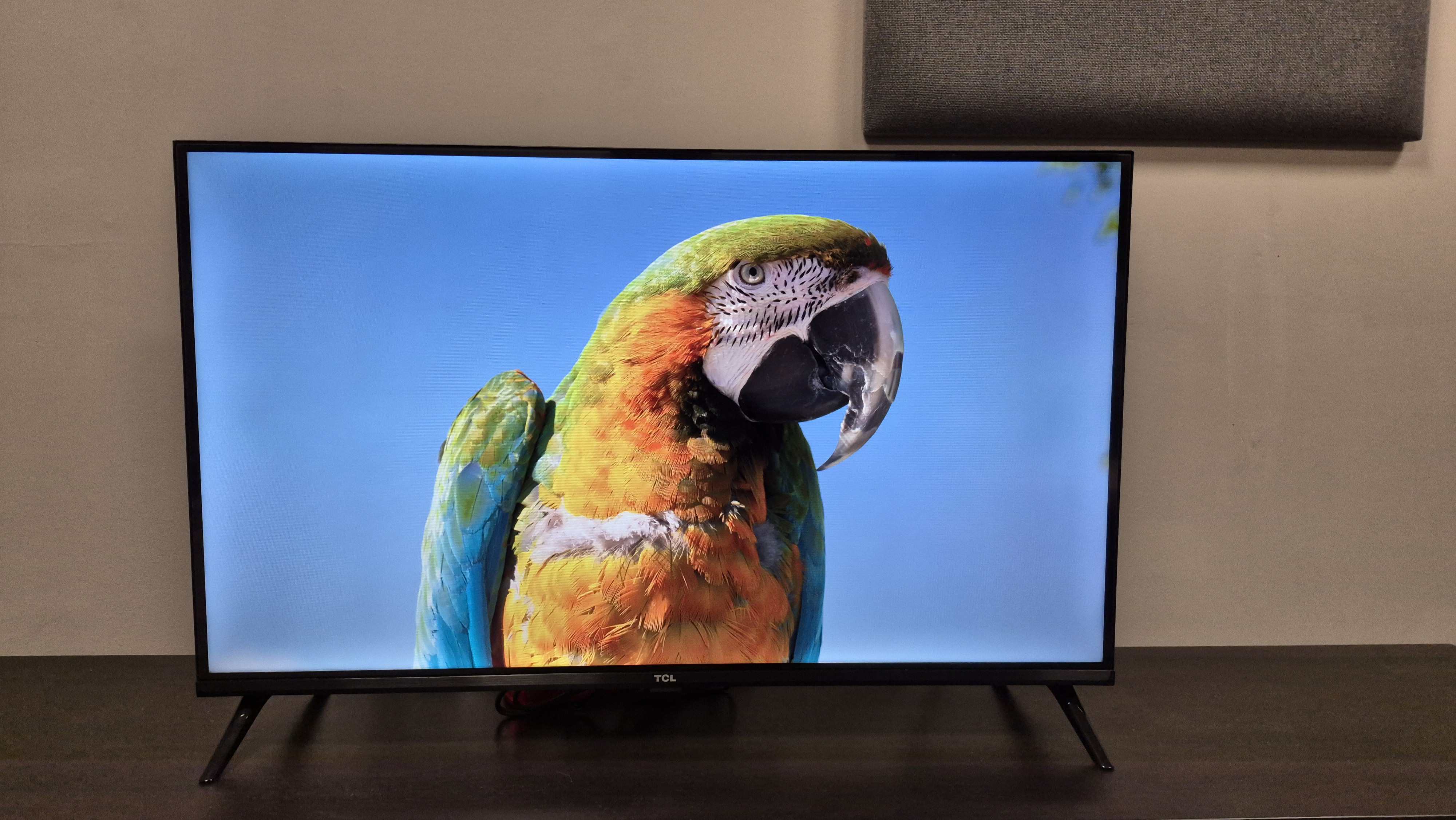
- Tested in our TV testing room using a range of lighting conditions
- Measurements taken with Portrait Displays’ Calman software
- Tested across a variety of sources, both SDR and HDR
I tested the Toshiba 32LF2F53DB’s picture quality by watching video in both HDR and SDR. I viewed content from a range of platforms including Disney Plus and YouTube and while using the Sony UBP-X800M2 4K UHD Blu-ray Player. I also played Battlefield V on the XBox Series X to cover gaming performance.
When watching the Toshiba 32LF2F53DB, I selected video content that would expose the specific strengths and weaknesses of the TV. For instance, I watched Godzilla vs. Kong and Star Wars: The Last Jedi to assess elements like colour fidelity, contrast and black-levels. But I also watched Top Gun: Maverick and Sky News to judge competence in the sound department.
On top of that, I took measurements using Portrait Displays’ Calman calibration software. I measured peak brightness on a 10% window and 100% window in both SDR and HDR. I also recorded the Delta-E values (which demonstrates the margin of error between the test pattern and what is displayed) for colour accuracy, grayscale and gamma. Finally, I measured the colour space looking at DCI-P3 and BT.2020 coverage. For all tests, I used the Murideo Six 8K test pattern generator. If you want to find out more about the review process, you can read all about how we test TVs at TechRadar.
- First reviewed: November 2024
- Read more about how we test
